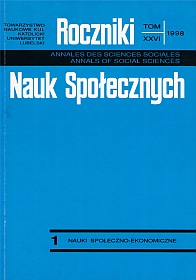Postawy młodzieży wobec śmierci
Abstrakt
Let us concentrate in our considerations on the following three questions: how often we think about death, the lay versus religious understanding of death. They allow us to learn about the attitudes the youth adopt towards dying and death. The thanatological attitudes of the secondary school leavers under study will be shown according to the three socio-demographic traits (sex, type of school and place of residence) and two religious traits (religious self-identifications and religious practices). The two special existential categories: sense of life and sense of death become, in a different way, the subject matter of the reflection of the young generation of Poles. Young secondary school leavers think about the sense of life more often than about the sense of death. If 13.1% of the subjects do not think at all about the sense of life, or think about it only rarely, the analogical index pertaining to the thanatological issues equals 42.4%. It is difficult to assess the declared frequency with which the young people think about death. The fact that almost half of the youth under study think, at least sometimes, about death, may provoke to ask questions about the sense of life and death, also when we consider life as a whole and search for the “sense of any sense.”
A considerable part of the secondary school leavers treat death as a kind of reality they cannot avoid, as a natural end of human life, and, consequently, speaking about it very often has no sense. The statements about death as a natural phenomenon were highly approved, but the statements about death, with the religious contents, were considerably less approved. In their assessments about the sense of life and death, some respondents would at the same time quote religious and lay justifications, the fact which can mean that they did not treat those justifications as exclusive but complementary.
The coefficients of correlations were, as a rule, high and significant in relation to the religious traits, and insignificant in relation to the socio-demographic traits. On the one hand, men and women, the youth from various schools, were comparable as regards the frequency with which they thought about death and the way they interpreted the phenomenon of dying and death and suffering. On the other hand, they differed when their attitudes towards religion were different and they did not carry out religious practices in the same way. The psychosocial and social dimension of growing old, dying and death should to a greater extent become the object of empirical research.
Copyright (c) 1998 Roczniki Nauk Społecznych

Utwór dostępny jest na licencji Creative Commons Uznanie autorstwa – Użycie niekomercyjne – Bez utworów zależnych 4.0 Międzynarodowe.


